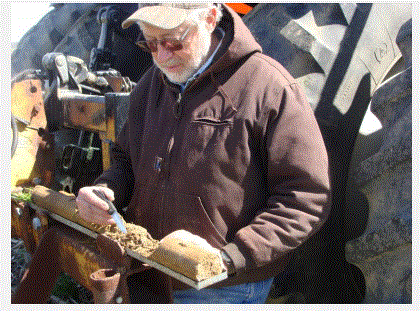Deep Rooting Annual Ryegrass Busts Compaction
In the last blog post, you learned that the Oregon Ryegrass Seed Commission funded field trials and research in the mid-to-late 1990s into mid 2000’s, to determine the ways in which annual ryegrass might be a beneficial cover crop. You also recall that this effort was triggered by an “ah-ha” that Oregon seed grower Don Wirth got from talking to Ohio farmers at the Farm Machinery Show, who were using annual ryegrass for grazing and sileage, but who found that it helped boost corn production in those same fields.
Don was so avid about the project that he carved out more time from his business to join the Ryegrass Commission board and voluntarily lead the new effort taking place in Illinois and Indiana. All seed companies were asked to donate annual ryegrass seed, specifically diploid ryegrass varieties, having two sets of chromosomes per cell instead of four (tetraploid varieties). These tend to be hardier in yield, even in less than ideal growing conditions. Don’s seed company agreed to mix and ship the seed at his expense.
The plan began by inviting innovative farmers already no-tilling to add annual ryegrass to their management practice. On his first trip back, Don met with a number of people, including no-till pioneer Jim Kinsella, veteran agronomist Mike Plumer, and Purdue University agriculture professor Eileen Kladivco. Oregon seed grower and Commission member Nick Bowers came on that trip, as did Commission administrator Bryan Ostlund.
In the first year of the program, Purdue helped to locate cooperative growers eager to try a small plot of annual ryegrass. “The fact that cover crops require a change in management practices, it was important to start by learning from mistakes on small plots,” Don said.

Among the first to try annual ryegrass included Dan DeSutter in Indiana and Ralph “Junior” Upton in Illinois. “Mike Plumer, an Extension agronomist at the University of Illinois, took me to Junior’s farm, a veteran of no-till who had begun experimenting with cover to reduce erosion,” Don continued. “He farms in Springerton, Illinois, on hilly, compacted and poorly drained soil that had very little topsoil when he started. The year after Junior planted annual ryegrass, Plumer returned and they dug into the field to look at root structure. They were dumbfounded to learn that annual ryegrass sent roots down to 40-plus inches deep, 10 inches deeper than either corn or beans were going that year.
In a tribute article to Junior’s innovative practices and willingness to teach others, No-Till Magazine gave him a “Legends of No-Till” award, along with an article, which is quoted below, in which different cover crops are discussed for their different benefits.
Cereal rye helps with weed control and soil erosion and is a great companion crop for the other cover crops. The root system of ryegrass helps to break up the fragipan in his soil and also assists with weed control. When managed properly, hairy vetch generates both supplemental nitrogen and additional weed control.
Some other early experimenters with annual ryegrass came to a different conclusion, based on some pretty awesome mistakes. “People thought annual ryegrass could become a pest if not controlled properly,” Don said, “and they’d be right about that. A weed specialist in Dickson Springs, Illinois, told me ‘anybody promoting and selling annual ryegrass is committing a crime!’ He based that on his failure using herbicide spray on the annual ryegrass in the spring. The booms on his sprayer were way too low and he was getting all kinds of skips in coverage,” Don added.
“Another weed scientist on the research farm in Jacksonville Tennessee, warned that annual ryegrass would easily develop a tolerance for glyphosate and other herbicides,” Don continued. “But, in his case, he was using a variety of annual ryegrass seed out of Australia (Lolium rigidum) instead of the varieties we grow in the U.S., which are all derived from Italian annual ryegrass (Lolium multiflorum). Again, these early mistakes are very useful, as we came to emphasize the importance of proper equipment and chemistry to successfully control the cover crop. In the 25 years we’ve been doing this, we haven’t heard yet of any horror stories of our varieties developing tolerance to herbicides.”
In the next blog, we’ll talk more about the methodical way in which Oregon seed growers and Midwest cooperating farmers began to flesh out the various benefits of annual ryegrass. We’ll also summarize the efforts seed growers undertook to develop new varieties that would be winter hardy and still be susceptible to burndown in the spring. And finally, you’ll hear about the innovation taking place in the timing of annual ryegrass seeding and the different ways being developed to apply the seed economically.

